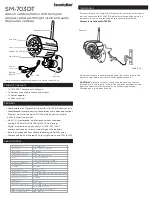
DSP-22-1 User Manual
Page 19 of 22
DSP-22-1_MAN_D
4.
Troubleshooting
No Power LED
The first step is to ensure that the correct model of the detector is being used for the installation. Ensure that the
wiring is correct, and the correct voltage is being used.
Use a meter to measure the voltage applied to the detector. The voltage must be between 14 volts and 27 volts
DC.
If the correct voltage is applied and the power LED is not on, replace the detector.
Detect LED Flashes On Once Every Two Seconds
This flash count indicates that the detector channel has an open loop, a high resistance in the loop circuit, or
excessive inductance.
The first step is to confirm that the channel has a loop connected to it and the loop is connected to the correct
loop terminals (see the wiring configuration for the pin out).
If a loop is connected to the correct terminals of the detector, disconnect the loop and using an ohmmeter, check
the resistance of the loop circuit. If the resistance is above 5 ohms there is a bad connection, or the wire has been
damaged. The resistance will typically be 1.5 ohms or less.
If the resistance is below 5 ohms, the loop inductance should be checked. This is done using an inductance meter.
The inductance of the loop should be less than 1500 microhenries. It is very unusual to have a loop with an
inductance value this high, but it is possible with very large loops and many turns. If the loop inductance value is
above 1500 microhenries, the loop will have to be replaced with a loop with less inductance. Contact technical
support for help with very large loops.
If you do not have a meter capable of measuring resistance and/or inductance but do have another operating
detector in the same box, you can skip to this step. Swap the loops between a working detector and a failing
detector. If the problem follows the loop the loop is the problem. If it stays in the same detector, replace the
detector.
Detect LED Flashes On Twice Every Two Seconds
This flash rate indicates that the channel has a shorted loop, a low resistance across the loop circuit, or insufficient
inductance.
The first step is to confirm that the loop is connected to the correct screw terminals. If the wiring is correct, the
next step is to confirm that the detector is working correctly. Disconnect the loop wires for the detector. The LED
should begin flashing just once every two seconds. If it does not change its flash count, change the detector.




































